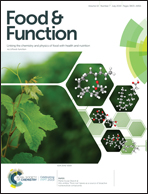A surface-layer protein from Lactobacillus acidophilus NCFM induces autophagic death in HCT116 cells requiring ROS-mediated modulation of mTOR and JNK signaling pathways†
Abstract
A surface-layer protein (Slp) derived from Lactobacillus acidophilus NCFM has been reported to possess multiple biological properties, including anti-inflammatory, inhibition of apoptosis in pathogen-invaded HT-29 cells and oxidative stress relief. However, its anti-tumor ability and underlying molecular mechanism are unknown. Here, we report that Slp suppresses cell proliferation and induces autophagic cell death in HCT116 cells. Accumulation of Beclin-1 and microtubule-associated protein 1 light chain 3 from II (LC3-II), and the degradation of p62 were observed when cells were treated with various concentrations of Slp (25, 50, 100 μg mL−1) for 24 h. We also found that the mammalian targets of rapamycin (mTOR) and c-Jun N-terminal kinase (JNK) signaling pathways were crucial mediators regulating Slp-induced autophagic cell death. Additionally, treatment with Slp resulted in the obvious formation of reactive oxygen species (ROS). SP600125, a JNK inhibitor, and N-acetylcysteine (NAC), a ROS inhibitor, attenuated Slp-induced autophagic cell death in HCT116 cells. Furthermore, NAC was found to prevent Slp-induced p70 and JNK phosphorylation. Taken together, our results suggest a novel mechanism of action of Slp induced autophagy, acting simultaneously through the ROS-mediated mTOR and JNK signaling pathways in HCT116 colon cancer cells.



 Please wait while we load your content...
Please wait while we load your content...